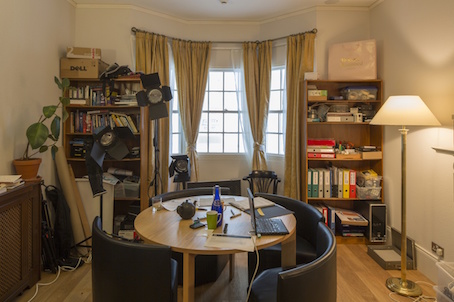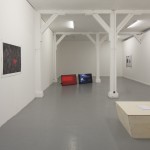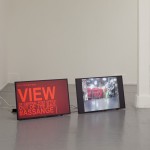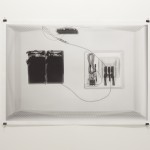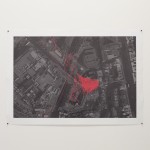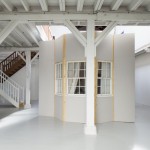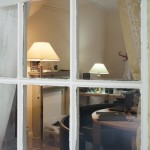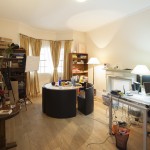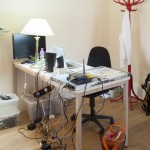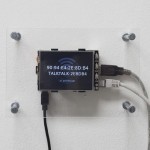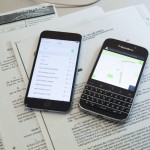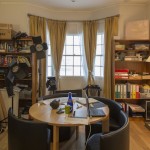Scroll down for English text
!Mediengruppe Bitnik
Featuring Adam Harvey
Welcome to Ecuador
25.06_29.10. 2016
Il est désormais avéré1 que nous nous réfrénons dans nos vies en ligne car nous avons parfaitement intégré le fait que nos gestes digitaux sont sous constante surveillance. Se pose alors d’évidence la question du devenir du savoir dans une société dont les membres s’auto-censurent et préfèrent regarder des vidéos de chatons et tenir des conversations sexy avec des chatbots2. (Qui sommes-nous quand nous nous savons observés ? Celui que nous sommes profondément ou celui que l’on préfère donner à penser que l’on est ? D’aucuns n’hésitent pas à arguer que l’on serait plus honnête lorsque l’on s’adresse à un robot3.) Contrôle à distance des populations par intimidation : le principe n’est bien sûr pas nouveau ni sans rappeler certaines formes totalitaires d’organisation sociale, bien qu’ici le procédé opère en négatif, ce ne sont pas tant des pensées qui sont imposées que des informations qui sont dissimulées.
Lorsqu’il co-fonde WikiLeaks en 2006, Julian Assange a pour objectif de publier des informations qui permettent de comprendre comment le monde fonctionne réellement4, convaincu qu’« avec des mathématiques ingénieuses, […] on peut permettre à n’importe quel individu de s’opposer au plus puissant État.5 » Publish or Perish6, ainsi qu’il le résume. C’est avec la mise en ligne de la fameuse vidéo d’un raid aérien américain sur Bagdad montrant des civils, et notamment deux photographes de l’agence Reuters, fusillés en pleine rue que le site acquiert une audience mondiale. On est alors en 2010. L’enchaînement des événements est connu : la demande d’extradition d’Assange formulée par la Suède pour une affaire privée dont les répercussions pourraient être son incarcération aux États-Unis, tout comme pour la lanceuse d’alerte Chelsea Manning, condamnée à 35 ans de réclusion dans une prison militaire.
 Le 19 juin 2012, Julian Assange entre alors dans l’ambassade d’Equateur à Londres pour n’en plus ressortir à ce jour. Six mois plus tard, poursuivant l’idée de « casser cette barrière physique autour de l’ambassade » de gardes protocolaires mais aussi de nombreux policiers, activistes, journalistes et curieux, !Mediengruppe Bitnik adresse un colis à Julian Assange, un colis un peu spécial doté d’un téléphone en mode GPS et appareil photo programmé pour prendre une image toutes les dix secondes et l’uploader dans l’instant sur Twitter. Plusieurs batteries y sont reliées pour lui permettre d’assurer son suivi en direct tout au long de son trajet dans Londres, du bureau de poste d’Hackney à l’ambassade. Cette performance de Mail Art du troisième millénaire dure trente-six heures, trente-six heures pendant lesquelles elle tient en haleine un certain nombre de followers mais aussi les téléspectateurs lambda de la BBC qui la retransmet elle aussi en direct. Pour ceux qui n’étaient pas devant leur écran les 16 et 17 janvier 2013, la vidéo qui en résulte fera office de séance de rattrapage. Delivery for Mr. Assange, assemblage des photos prises par le « postdrone » rythmé par les tweets documentaires qui accompagnent chacune d’elles, provoque un éclatement de l’habituelle continuité du temps tout en provoquant une fascination haletante.
Le 19 juin 2012, Julian Assange entre alors dans l’ambassade d’Equateur à Londres pour n’en plus ressortir à ce jour. Six mois plus tard, poursuivant l’idée de « casser cette barrière physique autour de l’ambassade » de gardes protocolaires mais aussi de nombreux policiers, activistes, journalistes et curieux, !Mediengruppe Bitnik adresse un colis à Julian Assange, un colis un peu spécial doté d’un téléphone en mode GPS et appareil photo programmé pour prendre une image toutes les dix secondes et l’uploader dans l’instant sur Twitter. Plusieurs batteries y sont reliées pour lui permettre d’assurer son suivi en direct tout au long de son trajet dans Londres, du bureau de poste d’Hackney à l’ambassade. Cette performance de Mail Art du troisième millénaire dure trente-six heures, trente-six heures pendant lesquelles elle tient en haleine un certain nombre de followers mais aussi les téléspectateurs lambda de la BBC qui la retransmet elle aussi en direct. Pour ceux qui n’étaient pas devant leur écran les 16 et 17 janvier 2013, la vidéo qui en résulte fera office de séance de rattrapage. Delivery for Mr. Assange, assemblage des photos prises par le « postdrone » rythmé par les tweets documentaires qui accompagnent chacune d’elles, provoque un éclatement de l’habituelle continuité du temps tout en provoquant une fascination haletante.
Après plusieurs visites physiquement rendues à Julian Assange et un projet mené conjointement avec lui (Delivery for Mr. Rajab7, 2013), le duo zurichois choisit de reproduire à l’échelle 1 et à l’identique le désormais célèbre bureau qu’occupe Assange à l’ambassade d’Equateur depuis bientôt quatre ans. S’il ne peut quitter cet espace sous aucun prétexte sous peine d’être immédiatement arrêté par la police britannique qui encercle l’ambassade, il ne peut non plus franchement le donner à voir pour d’évidentes raisons de sécurité.
Cette réplique est donc réalisée de mémoire — du fait de l’interdiction de prendre des photos au sein de l’ambassade — par les artistes.
C’est à pénétrer l’univers clos de Julian Assange depuis ces quatre ans de réclusion « volontaire » qu’invite aujourd’hui !Mediengruppe Bitnik. Incarnation du centre névralgique de WikiLeaks, cet espace sans extérieur, délibérément présenté comme un décor à l’envers brut, permet de faire l’expérience de la claustration du plus célèbre des hacktivistes. La Assange’s Room est évidemment un projet éminemment politique au premier abord mais aussi via les considérations sur l’espace qu’elle met en œuvre : que signifie l’inclusion d’un espace dans un autre ? La reproduction d’une sensation spatiale est-elle possible8 ? Ce petit bureau qui suscite la plus grande curiosité du public comme des médias donne à envisager cette curiosité comme le pendant de celle des gouvernants à notre égard, celle qui se manifeste par la surveillance quasi généralisée de nos faits et gestes comme de nos dits et écrits. Ce petit bureau, symbole depuis le 19 juin 2012 du fait que l’entrave à la liberté d’aller et venir ne sera jamais une entrave à celle de faire transparaître les vérités.
Afin d’intensifier l’expérience, Adam Harvey a spécialement créé SKYLIFT, un émulateur de géolocalisation qui transporte virtuellement les visiteurs dans l’ambassade londonienne. Le dispositif retransmet des signaux wifi qui exploitent l’utilisation par les smartphones des adresses MAC environnantes dans le processus de localisation. Une fois en contact avec SKYLIFT, les smartphones des visiteurs sont approximativement localisés au 3 Hans Crescent, Knightsbridge, Londres. De là, il est par exemple possible de partager des photos qui seront taggées avec les coordonnées GPS de l’ambassade d’Equateur à Londres
1 « Jonathon Penney, doctorant à Oxford, a analysé le traffic sur Wikipédia les mois précédant et suivant les révélations concernant l’espionnage mené par la NSA en 2013. Il a remarqué par la suite une baisse de 20% des visites sur les pages des articles liés au terrorisme, notamment ceux mentionnant les termes ‘al-Quaeda’, ‘voiture piégée’ ou ‘Taliban’ ». https://www.washingtonpost.com/news/wonk/wp/2016/04/27/new-study-snowdens-disclosures-about-nsa-spying-had-a-scary-effect-on-free-speech/
2 is anyone home lol, le dernier projet en date de !Mediengruppe Bitnik au Kunsthaus Langenthal (CH) du 28 avril au 26 juin 2016, présente des chatbots (ou robots conversationnels) issus d’un site de rencontres en ligne qui les utilise pour feindre des profils d’utilisatrices. Lors du dévoilement de l’affaire des fembots d’Ashley Madison, il a été révélé que le site, qui attirait très peu d’utilisatrices réelles, « employait » quelque soixante-dix mille robots qui ont envoyé plus de 20 millions d’emails aux utilisateurs masculins du site. Un site qui affiche toujours d’affolants chiffres de fréquentation, même après le scandale.
3 Judith Donath, lors de Theorizing the Web, Museum of the Moving Image, Queens, New York, 15 avril 2016 : « When we know it’s a machine, we’re not trying to make a good impression on it. People tend to be more honest to bots ».
4,5,6 : Hans Ulrich Obrist « In conversation with Julian Assange » (2011), in e-flux journal, The Internet Does Not Exist, Sternberg Press, 2015, p. 209-218-217.
7 Après la réception par Julian Assange de son colis, !Mediengruppe Bitnik a proposé à ce dernier d’en faire parvenir un à la personne de son choix. C’est au militant des droits de l’homme alors emprisonné au Bahreïn Nabil Rajab qu’Assange a choisi de dédier son envoi.
8 L’on pensera immédiatement à l’appli de réalité virtuelle lancée par the Guardian en avril dernier qui reconstitue l’expérience d’une cellule d’isolement. http://www.theguardian.com/world/ng-interactive/2016/apr/27/6×9-a-virtual-experience-of-solitary-confinement
Environ 100 000 personnes sont détenues dans ces conditions aux Etats-Unis. Chelsea Manning y a passé 9 mois. http://www.theguardian.com/world/commentisfree/2016/may/02/solitary-confinement-is-solitary-confinement-is-torture-6×9-cells-chelsea-manningno-touch-torture-and-it-must-be-abolished
Commissariat : Aude Launay
Télécharger le dossier de presse : DPMediengruppeBitnikAdamHarvey
!Mediengruppe Bitnik
Featuring Adam Harvey
Welcome to Ecuador
25.06_29.10. 2016
Curated by: Aude Launay
Since it is now proven1 that we are curbing our online lives, because we have thoroughly taken onboard the fact that our digital gestures are under constant surveillance, the following issue obviously rears its head: what is the future of knowledge in a society whose members censure themselves and prefer watching kittens videos and having sexy conversations with chatbots?2 (Who are we when we know we’re being watched? Are we the person we profoundly are, or the person we prefer people to think we are? There are some who unhesitatingly argue that we would be more honest if we addressed a robot.)3 Remote control of populations by intimidation: needless to say, the principle is not a new one, calling to mind certain totalitarian forms of social organization, although here the procedure works in a negative way: it is not so much thought that is being dictated as information that is being disguised.
When Julian Assange founded WikiLeaks in 2006, his intent was to publish information to explain how the world really works,4 persuaded as he was that “with some clever mathematics you can (…) enable any indivudual to say no to the most powerful state.”5 Publish or Perish,6 as he summed this up. It was with the online release of the famous video of an American air raid on Baghdad, showing civilians, and in particular two Reuters photographers, being openly mown down in a street, that the website acquired a worldwide audience. The year was 2010. The subsequent sequence of events is well-known: the demand for Assange’s extradition made by Sweden, based on a private matter, whose repercussions could well include his incarceration in the United States, just like the whistleblower, Chelsea Manning, who copped a 35-year sentence in a military prison.
On 19 June 2012, Julian Assange entered the Ecuadorean embassy in London, from which he has not since emerged. Six months later, pursuing the idea of breaking down the physical barrier around the embassy created by not only diplomatic guards but also large numbers of policemen, activists, journalists and curious bystanders, !Mediengruppe Bitnik sent a package to Julian Assange. A somewhat special package fitted with a telephone in GPS mode with its camera programmed to take a photo every ten seconds and instantly upload it on Twitter. Several batteries were hooked up to the parcel to make sure there would be live follow-up throughout its London journey from the humble post office in Hackney, to the embassy in posh Belgravia. This third-millennium Mail Art performance took 36 hours, a day and a half during which a certain number of followers were on tenterhooks, as were ordinary BBC TV viewers, watching the whole thing live. For those who were not glued to their screens on 16 and 17 January 2013, the resulting video will serve as a way of catching up. Delivery for Mr. Assange, an assemblage of photos taken by the “postdrone” punctuated by documentary tweets, shatters the usual continuity of time while at the same time giving rise to breathless fascination.
After physically visiting Julian Assange on several occasions, and in the wake of a project involving him as well (Delivery for Mr. Rajab,7 2013), the Zurich-based twosome decided to issue an identical 1:1reproduction of the now famous office which will soon have been Assange’s ‘home’ in the Ecuadorean embassy for four years. If he leaves his refuge for any reason whatsoever, he will be instantly arrested by the British police ringing the embassy, but he is also barred from openly showing his lodgings, for obvious security reasons.
This replica is thus made from memory by the artists, there being a ban on taking photos inside the embassy.
So today !Mediengruppe Bitnik is inviting you to enter the closed world which Julian Assange has been living in for these past four years of “voluntary” reclusion. As an embodiment of the WikiLeaks nerve centre, this space, which has no outside and is intentionally presented as a set, helps us to experience the confinement of the most famous of hacktivists. At first glance, Assange’s Room is obviously an egregiously political project, but not least because of the thoughts about space which it prompts: what is signified by the inclusion of one space within another? Is it possible to reproduce a spatial sensation?8 This small office which has aroused a great deal of curiosity among public and media alike turns this curiosity as the counterpart of our rulers’ curiosity about us, which manifests itself by their ubiquitous surveillance both of our doings and gestures, and of our words said and written. This small office has been, since 19 June 2012, a symbol of the fact that impeding the freedom to come and go will never interfere with the freedom to let the truth come out.
In order to intensify the experience, Adam Harvey specially conceived SKYLIFT, a geolocation emulator that virtually relocates visitors to the Ecuadorian Embassy in London. The device works by broadcasting WiFi signals that exploit a smartphone’s reliance on using nearby MAC addresses for location services. Once engaged with SKYLIFT, the visitors’ smartphone’s new approximate location will be 3 Hans Crescent Knightsbridge, London. There, they can check-in or share photos that will be tagged with latitude and longitude of the Ecuadorian Embassy in London.
1 “Jonathon Penney, a PhD candidate at Oxford, analyzed Wikipedia traffic in the months before and after the NSA’s spying became big news in 2013. Penney found a 20% decline in page views on Wikipedia articles related to terrorism, including those that mentioned ‘al-Qaeda’, ‘car bomb’ or ‘Taliban’”. https://www.washingtonpost.com/news/wonk/wp/2016/04/27/new-study-snowdens-disclosures-about-nsa-spying-had-a-scary-effect-on-free-speech/
2 is anyone home lol, the latest !Mediengruppe Bitnik project to date at the Kunsthaus Langenthal (Switzerland) from 28 April to 26 June 2016, presents chatbots from an online dating website which uses them to make up female user profiles. During the disclosure of the Ashley Madison fembot affair, it was revealed that the site, which attracts very few real female users, “employed” some 70,000 robots who sent more than 20 million emails to its male users. This is a site which still announces frightening user figures, even after the scandal.
3 During Theorizing the Web, Museum of the Moving Image, Queens, New York, 15 April 2016, Judith Donath observed: “When we know it’s a machine, we’re not trying to make a good impression on it. People tend to be more honest to bots”.
4,5,6 : Hans Ulrich Obrist “In conversation with Julian Assange” (2011), in e-flux journal, The Internet Does Not Exist, Sternberg Press, 2015, p. 209-218-217.
7 When Julian Assange had received his package, !Mediengruppe Bitnik offered him to send one to a person in a similar situation. Assange decided to dedicate his parcel to the human rights activist Nabeel Rajab, at that time in a maximum security prison in Bahrein.
8 We’ll think of the virtual reality app launched by the Guardian last April which places the viewer inside a US solitary confinement prison cell. http://www.theguardian.com/world/ng-interactive/2016/apr/27/6×9-a-virtual-experience-of-solitary-confinement
It is estimated that between 80,000 and 100,000 people are locked in solitary confinement in the United States. Chelsea Manning spend 9 months in one of those. http://www.theguardian.com/world/commentisfree/2016/may/02/solitary-confinement-is-solitary-confinement-is-torture-6×9-cells-chelsea-manningno-touch-torture-and-it-must-be-abolished
Download the press kit : PressKit-MediengruppeBitnik-AdamHarvey.pdf
-
Adam Harvey, SKYLIFT, 2016. Photos : Philippe Piron
- Adam Harvey, SKYLIFT, 2016. Photos : Philippe Piron
Cette exposition a reçu le soutien de Pro Helvetia, Fondation suisse pour la culture
This exhibition has been supported by Pro Helvetia, Fondation suisse pour la culture



